Amazingly Cool Classic Science | Yeast Science Experiment
Every kid should do at least several classic science experiments before they get too old to enjoy them. On the list today was the classic yeast science experiment. We decided to find out what type of sugar helped yeast grow best, or if sugar helps at all.
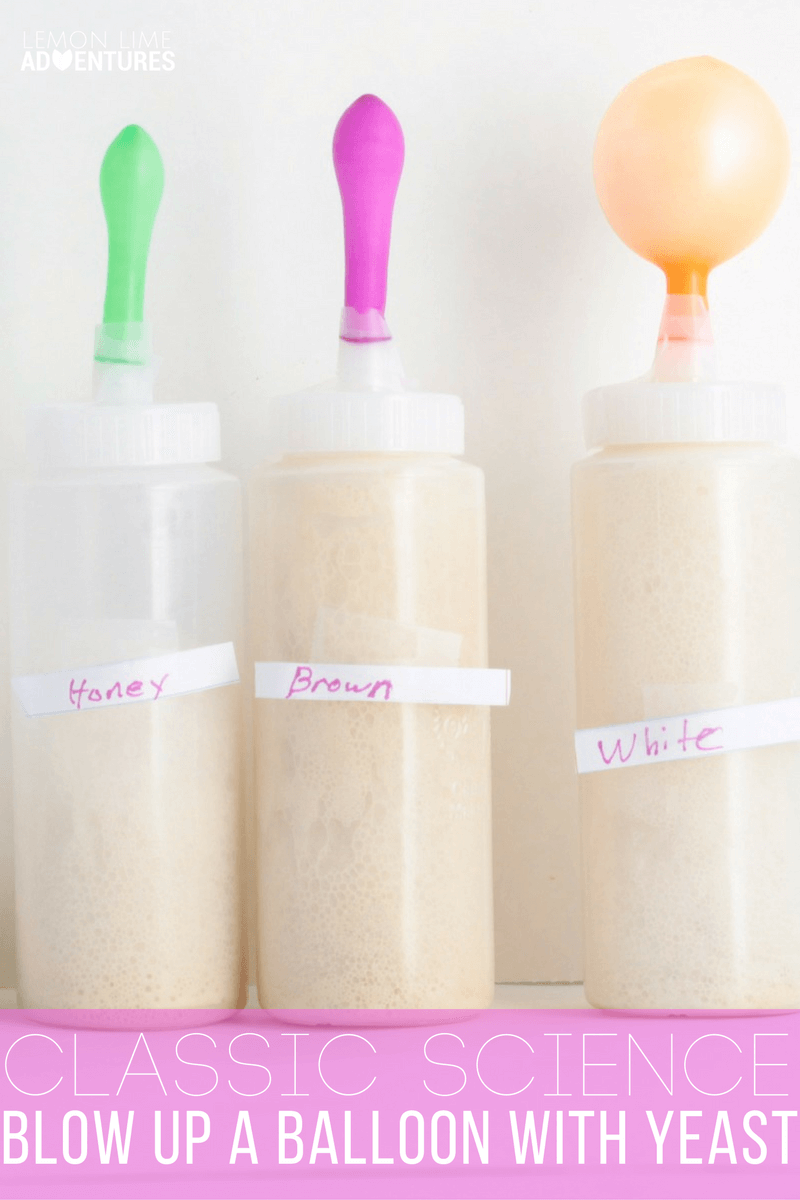
* This post may contain affiliate links for your convenience. Click here for my full disclosure.
We are on a small kick to explore foods that we eat at a Thanksgiving Feast and of course, bread is a very popular item. When the kids saw the dough rising in the bowl, they immediately had questions that they wanted answers to. That’s when I thought this would be the perfect way to explain the way yeast works.

Classic Yeast Science Experiment
What you’ll need for the yeast science experiment:.
- 3 types of sugar (we used brown sugar, white sugar, and honey)
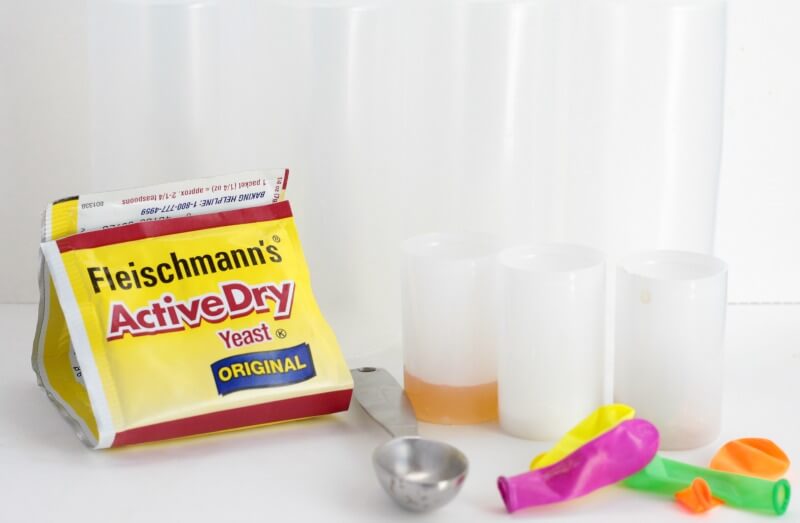
I set everything up in advance of this project so the kids could jump right in. I measured 2 teaspoons of each type of sugar into four mini containers (we used film canisters) and laid everything out on the table for the kids to use.
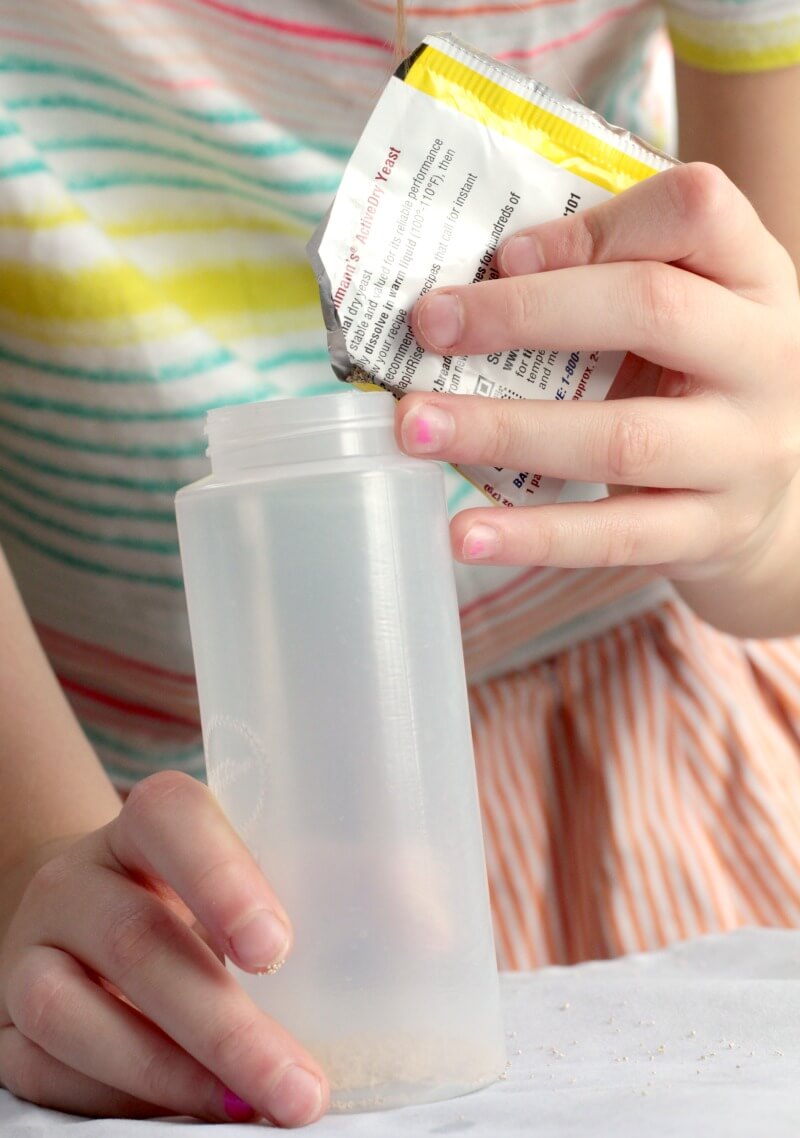
The kids poured half a packet of yeast into each bottle, then added two teaspoons of warm water.

The kids next added one type of sugar to three bottles, but nothing to the last bottle. We labeled each bottle to keep track of what sugar was wear.
A little shake mixed up the bottles and we could already see the yeast starting to grow!
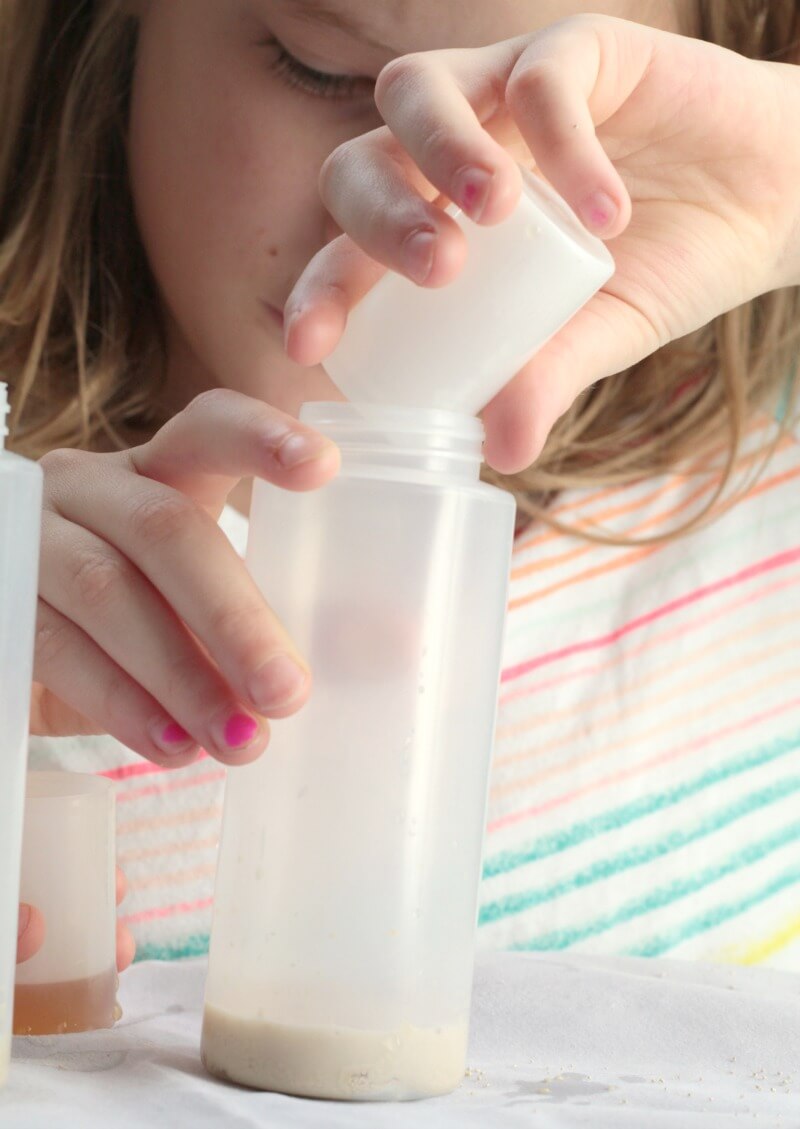
The kids screwed the caps back on the bottles and taped a water balloon to the top of each bottle spout (we had blown them up previously to stretch them out and make them easier to expand).
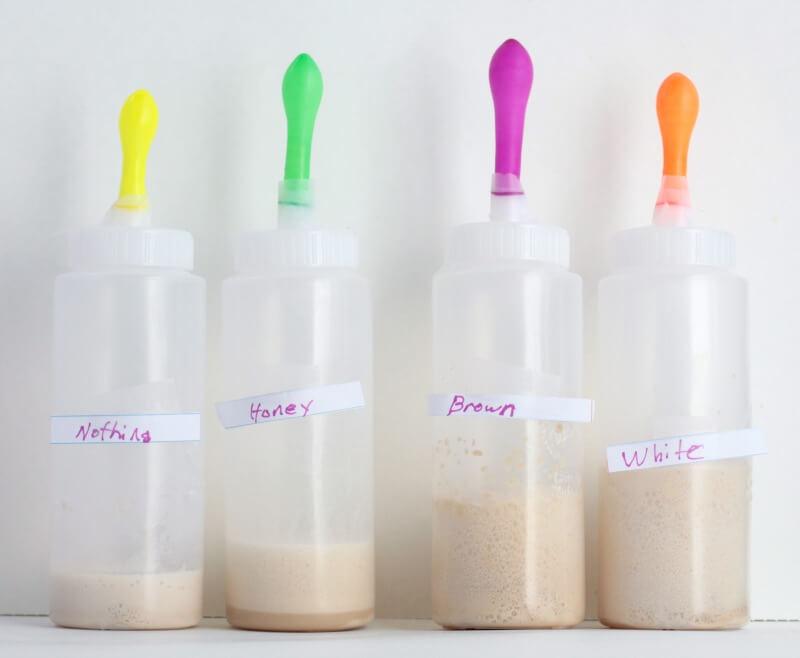
We set the bottles of yeast aside for 30 minutes, then came back to check our results.
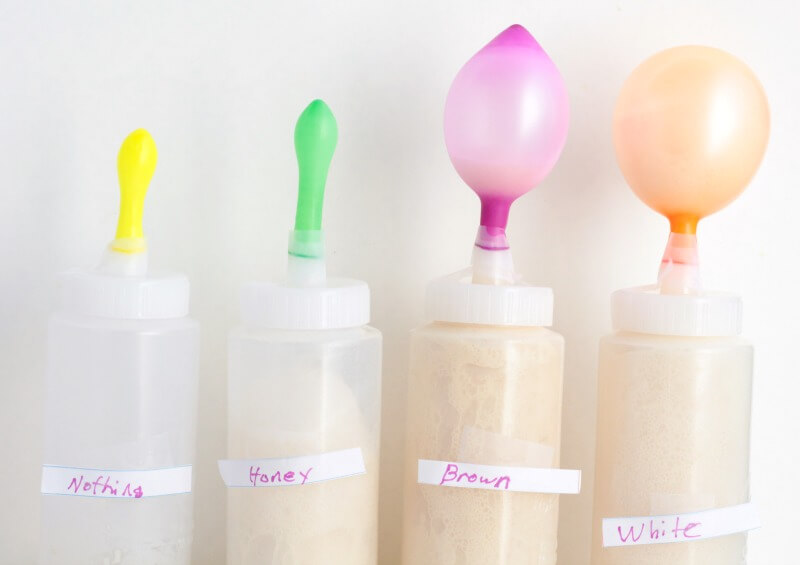
Although it looked like the brown sugar activated the yeast the fastest, over the 30-minute period the white sugar outpaced it. The honey eventually blew up the balloon, but it took about an hour. The nothing jar never had enough air to blow up its balloon.
We were curious, so we put our yeast bottles into the bathtub and left it for several hours. That night, we looked at our bottles again. The white sugar bottle had enough pressure to pop the balloon off the top. The honey and brown sugar bottles had balloons almost completely filled with yeast. The no-sugar bottle was still sad and deflated.
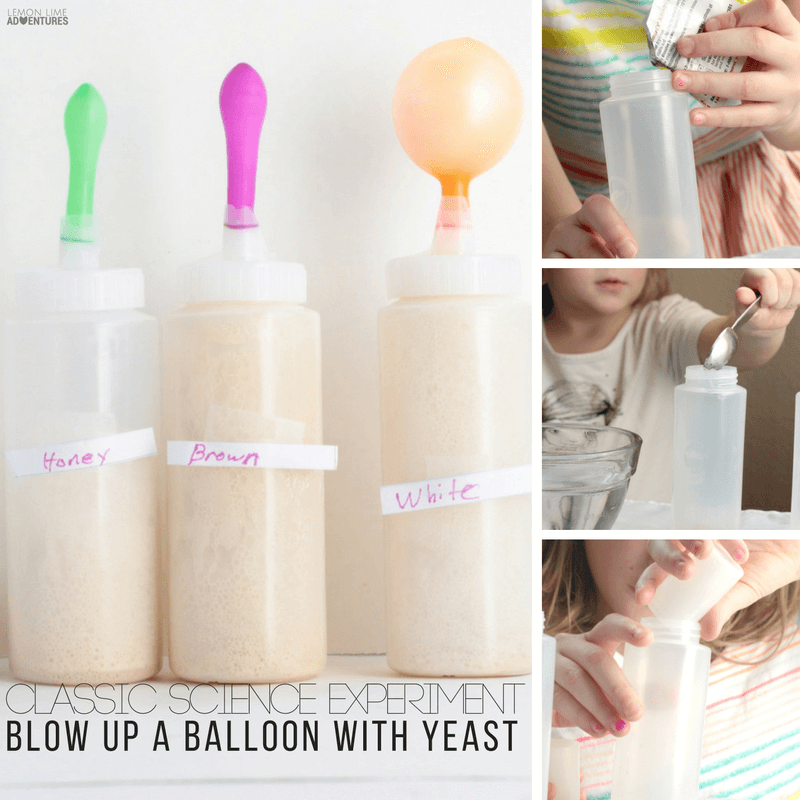
The kids determined that if we wanted to make fluffy bread, we definitely should feed our yeast white sugar.
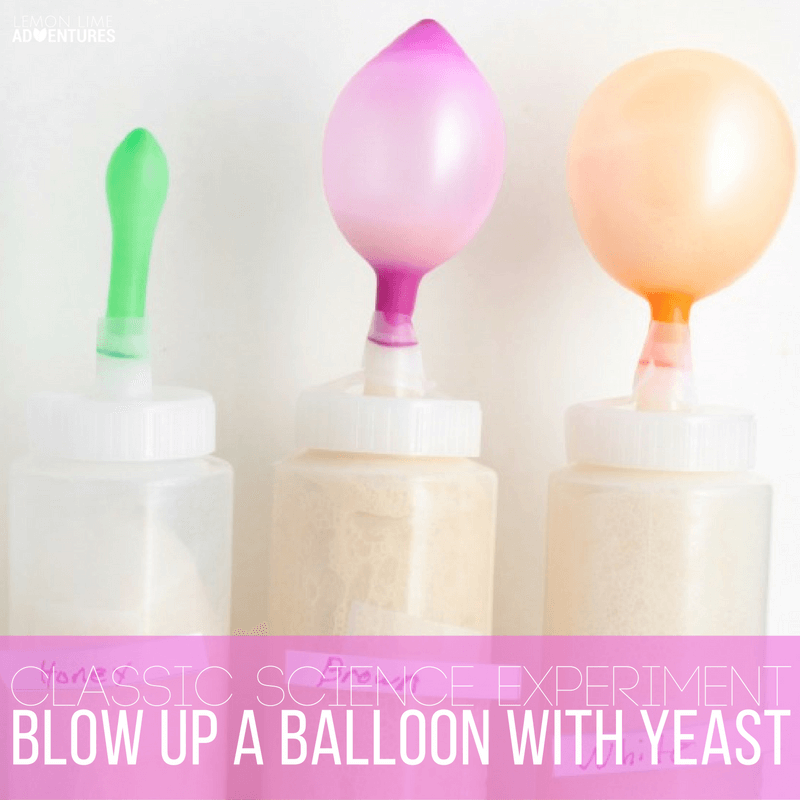
Looking for more STEAM (Science, Technology, Engineering, Arts and Math) projects and inspiration?
Check out my new book STEAM Kids Christmas and get a FREE STEAM Kids Coloring book if you buy during launch week! You can get both books (eBook PDF format) for only $9.99! But the sale and bonus book offer ends November 21 , so grab your copy now and don’t miss out!

Get more information on STEAM Kids Christmas by clicking here . Or go order your copy now! eBook PDF or Paperback

You can also get a bundle with our best selling STEAM Kids book, STEAM Christmas and STEAM Kids Coloring book for one low price: Click here to get your bundle today !
Not quite ready to jump in, don’t worry… you can hop over and grab a FREE Preview which includes 2 sample activities, 6 sample challenge cards, and the table of contents of the book!
For more adventures in STEM Learning, check out:
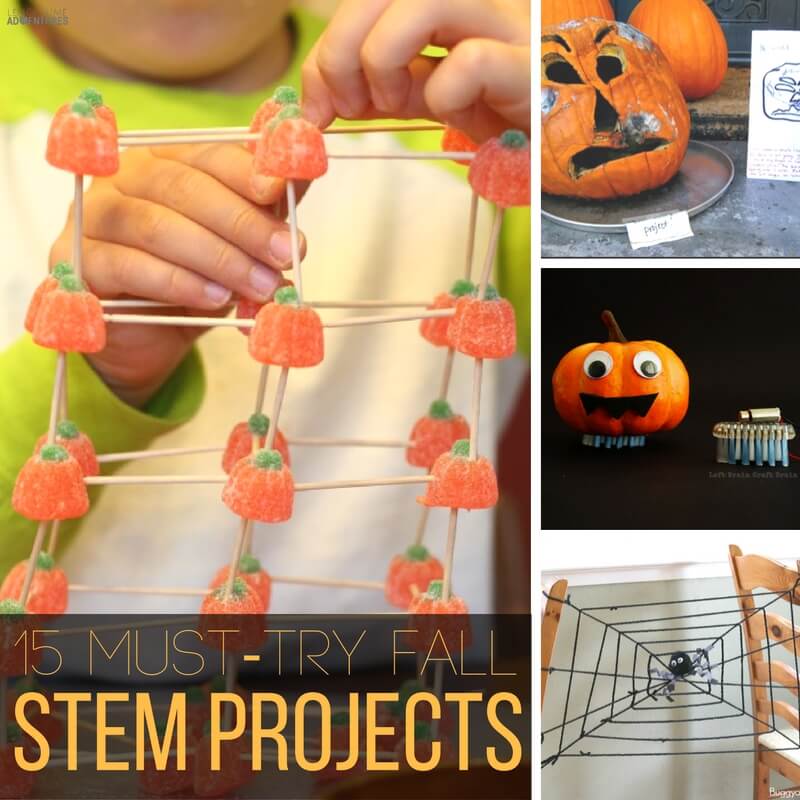
FREE DOWNLOAD
Discover how to get siblings to get along even when all they do is annoy each other with the Sibling “Get Along” Poster Pack!
1 thought on “Amazingly Cool Classic Science | Yeast Science Experiment”
Pingback: The Coolest Science Fair Projects for Kids - Left Brain Craft Brain
Leave a Comment Cancel Reply
Your email address will not be published. Required fields are marked *
Save my name, email, and website in this browser for the next time I comment.

CONNECT WITH ME
- Login | Register
Have 10% off on us on your first purchase - Use code NOW10
Free shipping for orders over $100
Available for dispatch within 2 days
Free gift with purchase of over $100
Check out with Paypal and Afterpay
Grow yeast experiment
Follow FizzicsEd 150 Science Experiments:
You Will Need:
- 4 packets of dry yeast
- 4 water bottles, chilled in the fridge (we use Thank You Water, a social enterprise that works to get clean water & sanitation to people in need)
- 1 large jug.
- 4 measuring cups.
- 4 thermometers (one will do if you don’t have a class set).
- Access to boiling water plus adult supervision.
- 1 stopwatch.
- A pen to mark the water temperature on each water bottle during the experiment.
- A shelf to leave the science experiment to run.
- A notebook for your observations.

- Instruction
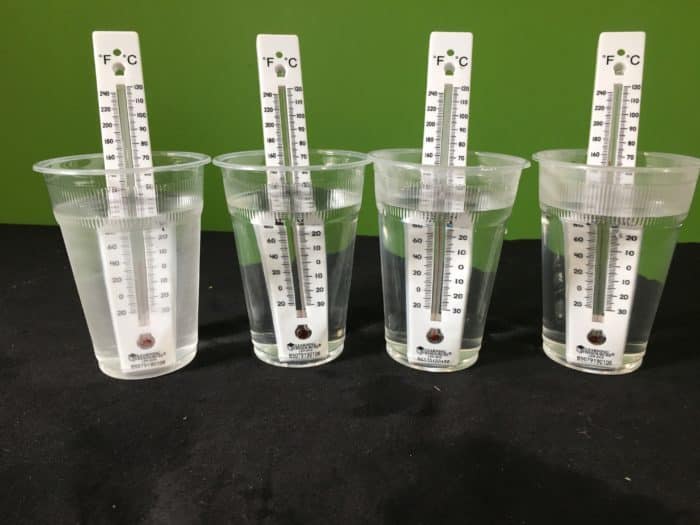
Pour out the 4 chilled water bottles into the large jug and discard the rest of the water (maybe water your school garden !)
Carefully measure out the water into the four measuring cups as per the measurements below;
Cup 1 – 200mL of chilled water
Cup 2 – 150mL of chilled water
Cup 3 – 100mL of chilled water
Cup 4 – 50mL of chilled water
Use the thermometers to take a measurement of the water temperature in each cup (write this in your notebook).
With an adult, boil a jug of water and then top up cups 2, 3 and 4 so that they too have 200mL of water as per cup 1. You will be testing the effect of temperature on the growth of yeast by measuring how much gas is released by the yeast under 4 different temperature conditions ( variable testing ).
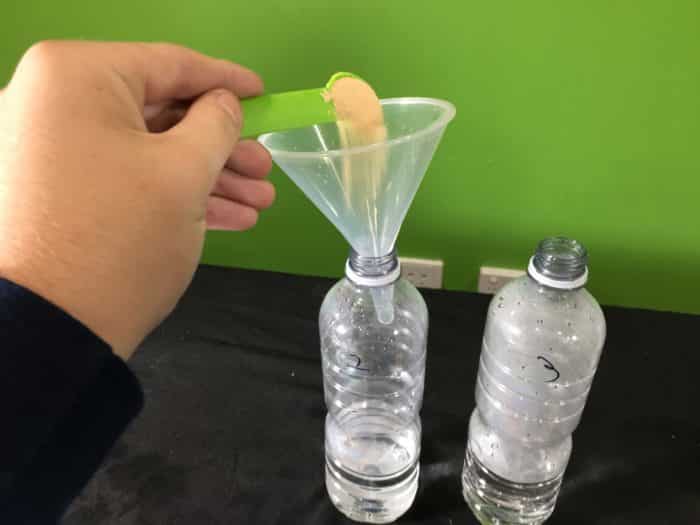
Using a funnel, carefully pour each cup of water into the four separate water bottles. Use the pen to mark the starting temperature of each water bottle.
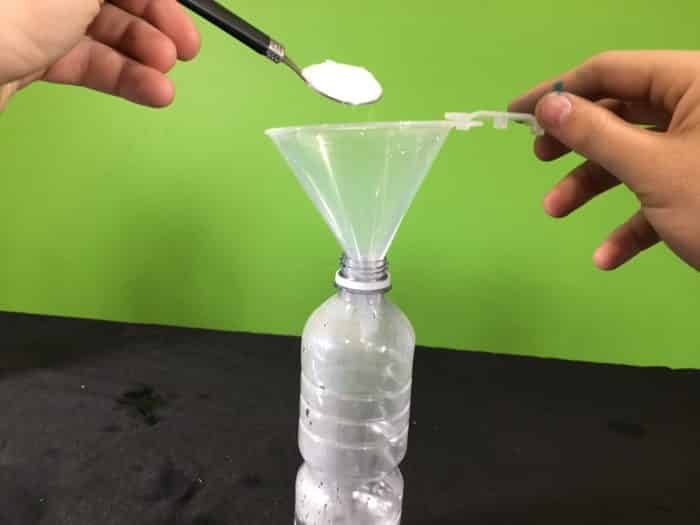
Add a spoonful of sugar per water bottle and then swirl the bottle to dissolve the sugar.
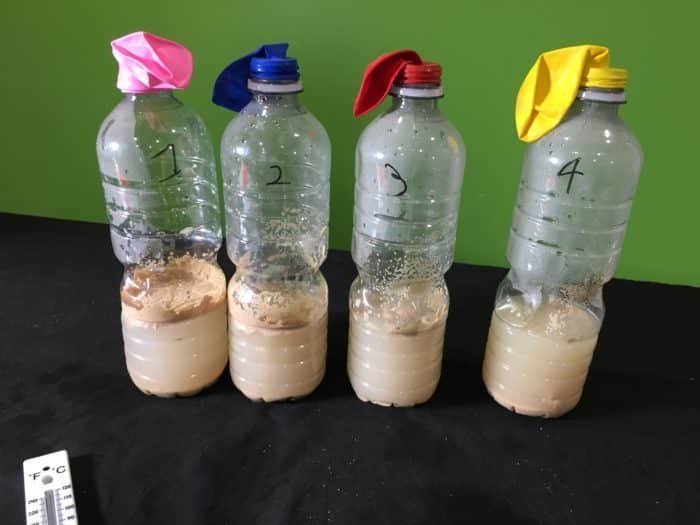
Add a yeast packet into each bottle and quickly stretch a balloon of the opening of each bottle.
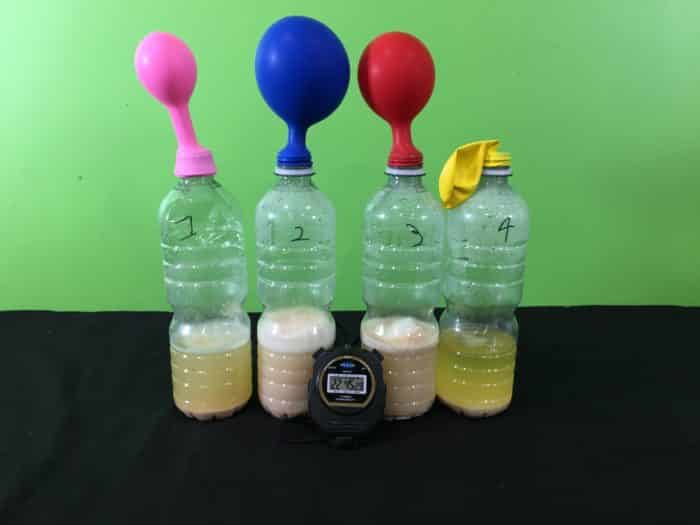
4 yeast growth experiments started, showing a distinct change already!
Start the stopwatch and take notes of when each balloon rises!
OPTIONAL: you could also keep each bottle in the yeast experiment at the same temperature and vary the amount of sugar added instead.
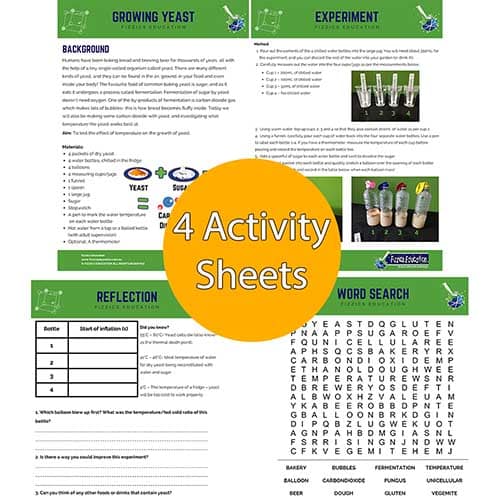
Go further – buy 4 x student activity sheets as extension worksheets.
This student science booklet has been created by experienced science educators from the Fizzics Education team.
Use these student worksheets as blackline masters for your science class!
See all student sheets here
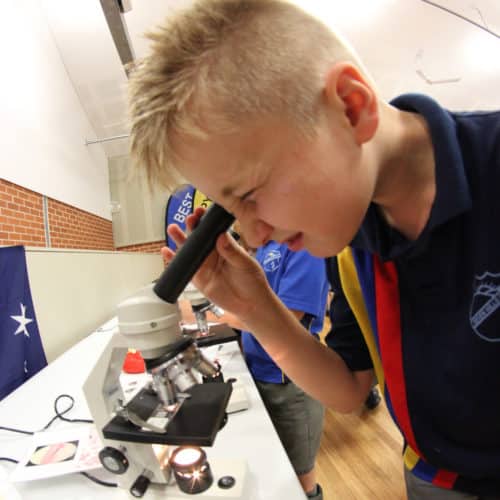
School science visits since 2004!
– Curriculum-linked & award-winning incursions.
– Over 40 primary & high school programs to choose from.
– Designed by experienced educators.
– Over 2 million students reached.
– Face to face incursions & online programs available.
– Early learning centre visits too!
Online courses for teachers & parents
– Help students learn how science really works
What is going on?
Your experiment was testing the effect of water temperature on the growth of yeast. Yeast are egg-shaped microscopic cells of fungi that are dormant whilst kept in dry and cool conditions. However, yeast will rapidly divide once exposed to water and sugar in ideal temperatures. In the right temperature, yeast cells will change the sugar into glucose by using the water plus as an enzyme catalyst (invertase). Once the yeast has converted the sugar to glucose fermentation can then occur to produce carbon dioxide and ethanol as per the equation below;
Glucose ⟶ Ethanol + Carbon dioxide
which can be written as…
C 6 H 12 O 6(aq) ⟶ 2C 2 H 5 OH (aq) + 2CO 2(g)
In your experiment, you were trapping the carbon dioxide released during the fermentation process. The more active the yeast, the more carbon dioxide the yeast produced! In your experiment, the different water temperatures will have produced different results as bottles may have been too hot for the yeast to survive whereas the other bottles may have been too cold. By introducing a variable to test in your experiment, you’re doing real science! The following list of temperatures is worth keeping in mind when assessing your results:
- 55° C – 60° C Yeast cells die (also known as the thermal death point).
- 41° C – 46° C Ideal temperature of water for dry yeast being reconstituted with water and sugar.
- 4° C The temperature of a fridge – yeast will be too cold to work properly.
Yeast is used to make bread rise and to ferment beer. There are many different species of yeast, but the one most commonly used in cooking and baking is called Saccharomyces cerevisiae , which is also known as brewer’s yeast.
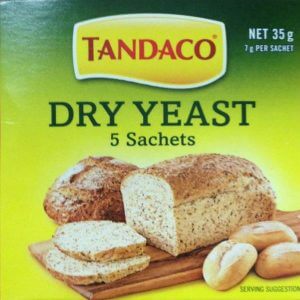
Yeast can break down many types of simple carbohydrates (monosaccharides) however they cannot break down complex carbohydrates such as starch. This means that extra enzymes are needed to break down starch into sugars that the yeast can use, for example during beer production we use enzymes from germinating barley to do this.
Variables to test
More on variables here
- Try different concentrations of vinegar as the growth medium. Can the yeast handle some acidity?
- Vary the amount of sugar used.
- Does the volume of water make a difference?
Classroom activity sheets for this experiment
Create, reflect & extend!

Learn more!
From colour changes to slimy science, we’ve got your kitchen chemistry & biological science covered! Get in touch with FizzicsEd to find out how we can work with your class.
Digital Microscopy
Years 3 to 6
Maximum 30 students
School workshop (NSW & VIC)
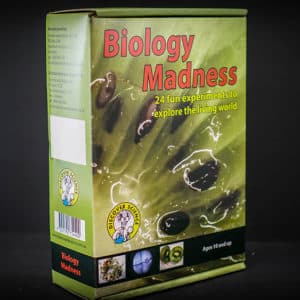
Biology Madness Science Kit
Stem full day accelerator - primary.
Designed from real classroom experiences, this modular day helps you create consistently effective science learning that directly address the new curriculum with easily accessible and cost-effective materials.

Be Amazing! How to teach science, the way primary kids love.
Love science subscribe.
Receive more lesson plans and fun science ideas.
SCIENCE PARTIES
Calendar of events.

HIGH SCHOOL Science@Home 4-Week Membership 12PM: March 2024
Price: $50 - $900

PRIMARY Science@Home 4-Week Membership 2PM: March 2024

Light and Colour Online Workshop, Jan 18 PM
Light and colour online workshop, jan 18 am.

Lego Robotics, Sydney Olympic Park Jan 2024

Creative Coding, Sydney Olympic Park Jan 2024

Creative Coding, Sydney Olympic Park July 11 2023
Price: $100

Fizzics Education STEAM Day: Robots vs Dinosaurs, Lalor, Apr 14
Price: $45 - $50
Creative Coding, Sydney Olympic Park April 14 2023
Science@home after school 4-week membership: march 2023.
Price: $40 - $1200
4 thoughts on “ Grow yeast experiment ”
What is the amount of water you would like me to put?
Hi! Here’s the detail’s that you need;
> Cup 1 – 200mL of chilled water > Cup 2 – 150mL of chilled water > Cup 3 – 100mL of chilled water > Cup 4 – 50mL of chilled water
With an adult, boil a jug of water and then top up cups 2, 3 and 4 so that they too have 200mL of water as per cup 1. You will be testing the effect of temperature on the growth of yeast by measuring how much gas is released by the yeast under 4 different temperature conditions.
Would this experiment still work if instead i tested how different types of sugars affect the amount of fermentation by yeast. Would i still get different sized balloons in my result.
We’d love it if you try this and let us know! With any experiment you just have to change one thing and then measure the result. So, changing the types of sugars is a completely valid investigation. Good luck!
Leave a Reply Cancel reply
Your email address will not be published. Required fields are marked *
School Comments View All
Fizzics Education curated a thoughtful and hands-on experience for the children, incorporating practical, skill-based learning activities and followed by a science presentation at the end of the event involving liquid nitrogen. This was delivered safely and effectively, capturing both the children and the parents for the duration of the presentation.
Fizzics Education ran a show today at our school and it was wonderful. He was a great facilitator and the show was age appropriate and well done.
I just wanted to pass on how much the staff and students really enjoyed it and how perfect it was to launch our science week activities. The students were enthralled, educated and entertained – a perfect trifecta!
Thanks so much for presenting at our school on Monday. Our students enjoyed the show.
Fizzics Education Awards

- Free Resources
Free Chemistry Book! Sign-up to our newsletter and receive a free book!
Female Accountant Apply Here
Physics teacher apply here, science teacher apply here, view all vacancies, join our team apply here.
Send us an Email at [email protected]
Phone Number: 1300 856 828
Email: [email protected], address: unit 10/55 fourth ave blacktown, nsw 2148, australia.
- Privacy & Legal Policy
- Copyright Notice
- Terms of Trade
- Cookie Policy
Copyright 2024 Fizzics Education . All rights reserved.
This website uses cookies to improve user experience. By using our website you consent to all cookies in accordance with our Cookie Policy .
Get more science with our newsletter!
Thank you for looking to subscribing to our newsletter 🙂 Through this service you’ll be first to know about the newest free experiments, science news and special offers.
PLUS: Get a free Kitchen Chemistry Booklet with >20 experiments, how to use variables plus a handy template!
Click the image to preview
Please select an ebook!

Kids Edition

Parent Edition

Teacher Edition
Please fill out the details below and an email will be sent to you. Once you get that just click on the link to confirm your subscription and you're all done!
First Name *
Last Name *
Email Address *
Phone Number
Subscribe as a Teacher?
Preschool Teacher
Primary Teacher
High School Teacher
Vacation Care or Library
Subscribe as a Parent?
Enquiry Form
Extra things, products that might interest you.


Rainbow Fireworks Glasses

Magic Crystal Tree Science Kit

Helicopter Spiral Top

Fly Back Glider
- Grade Level
Where are you located?
- Australian Capital Territory
- New South Wales
Location not listed?
Which grade level are you teaching.
- Whole School
- Teacher Professional Development
- Special School Events
- Early Childhood
- Kindergarten
Which broad syllabus outcome you want to teach?
What is the age range of the attendee?
- Age 5 and up
- Age 6 and up
- Age 7 and up
- Age 8 and up
- Age 9 and up
- Age 10 and up
- Age 11 and up
- Age 12 and up
General Enquiry Form
Check if you require a live online class.
Subscribe for special offers & receive free resources?
How did you hear about us?
Choose a program *
Choose from school show *
* Please select a value!
* Please add a value!
Date required *
Time required *
Log In to MyBinder
Forgot password
Don't have an account? Create one now!
View a MyBinder tutorial
Agricultural Literacy Curriculum Matrix
Lesson plan, grade levels, type of companion resource, content area standards, agricultural literacy outcomes, common core, food science: bread dough challenge, grade level.
Students explore the phenomenon of what makes bread dough rise. Using baker's yeast, students will observe alcoholic fermentation and its connection to cellular respiration as they are challenged to act as food scientists and develop the best recipe for quick-rising bread dough. Grades 9-12
Estimated Time
Two 1-hour sessions
Materials Needed
Engage:
- Time Lapse - Pizza Dough Rising video
Activity 1: What makes bread dough rise?
- 3 sandwich-sized Ziploc bags
- 1 tablespoon measuring spoon
- Food Science: Bread Dough Challenge handout , 1 per student
- Food Science: Bread Dough Challenge PowerPoint
Activity 2: Bread dough Challenge
- Food Science: Bread Dough Challenge handout, 1 per student (continued from Activity 1 )
- Bread Dough Challenge Variables sheet , 1 copy per class printed front to back, cut into quarters
- 1 glass Mason jar or clear glass beaker
- 1 cup flour
- 1 tablespoon sugar
- 1/3 cup warm water
- 1 teaspoon active dry yeast
- 1 teaspoon cooking oil
- 1 plastic spoon for stirring
- 1 paper/plastic bowl for mixing
- Rapid-rise yeast
- Vital wheat gluten
- 1 cup whole wheat flour
- 1 cup gluten-free flour (rice, coconut, oat, etc.)
- Sugar substitute such as Splenda
- Alternative sugar such as honey, brown sugar, or molasses
Essential Files
- (optional) Cellular Respiration Concept Map
alcoholic fermentation: an anaerobic pathway that converts the pyruvate made in glycolysis to ethanol, produces CO2, and regenerates NAD
anaerobic: without the use of oxygen
asexual reproduction: a form of reproduction involving a single parent and producing offspring that are exact genetic duplicates
budding: a form of asexual reproduction where parent cell forms a bubble-like bud that stays attached to the parent cell while it grows and develops; then breaks away to form a new organism
cellular respiration: process by which cells release energy from glucose and convert it to ATP
food science: the study of the physical, biological, and chemical makeup of food and the concepts underlying food processing
gluten: a tough, elastic protein substance in flour, especially from wheat, that holds dough together and makes it sticky
lactic acid fermentation: an anaerbic pathway that converts the pyruvate made in glycolysis to lactic acid, regenerating NAD
Did You Know?
- It takes 9 seconds for a combine to harvest enough wheat to make about 70 loaves of bread. 1
- Yeast are microorganisms. They are single-celled fungi. 2
- Yeast produces carbon dioxide when it consumes sugar. 3
- It takes 20 billion yeast cells to weigh one gram of cake yeast. 4
Background Agricultural Connections
This lesson can be nested into a storyline as an episode exploring the phenomenon of bread dough rising. In this episode, students investigate the question, "What makes bread dough rise?" Phenomena-based lessons include storylines which emerge based upon student questions. Other lesson plans in the National Agricultural Literacy Curriculum Matrix may be used as episodes to investigate student questions needing science-based explanations. For more information about phenomena storylines visit nextgenstorylines.org .
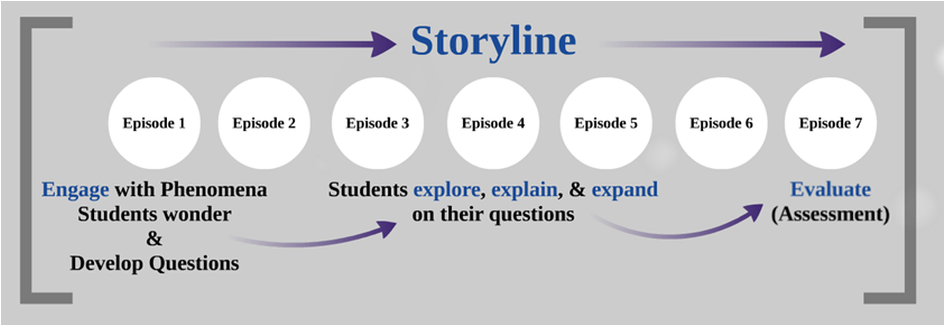
Cellular respiration can be a difficult topic for students to understand because it cannot be directly observed. In this lesson, students who have studied the basics of aerobic cellular respiration will be introduced to alcoholic fermentation and will conduct a simple experiment to determine how yeast gets energy from sugar. Students who aren’t familiar with using yeast in baking may wonder if it’s alive, which is another great opportunity for discussion.
Yeasts are unicellular fungi that reproduce asexually. The species Saccharomyces cerevisiae is used in bread baking and wine and beer brewing. S. cerevisiae is also used as a model organism in many laboratories because it is easy and inexpensive to culture. It is a facultative anaerobe, meaning that it undergoes both aerobic and anaerobic fermentation. In the absence of oxygen, yeast and other organisms undergo alcoholic fermentation, producing CO 2 and ethanol and regenerating the NAD+ needed to continue glycolysis. While this produces less ATP than aerobic respiration, some ATP is still produced.
Yeast cells do more than respire, they go through a form of asexual reproduction called budding. Asexual reproduction involves a single parent and results in offspring that are genetically identical to each other and to the parent. Budding occurs when a parent cell forms a bubble-like bud that stays attached to the parent cell while it grows and develops. Then, it breaks away and forms a new organism.
Students may be interested to learn that yeast is all around us; sourdough bread is made by allowing yeast in the air and in the flour to colonize a mixture of flour and water. The CO 2 produced during yeast metabolism is captured in bread dough, causing it to rise. The protein gluten provides a structure for the bubbles of CO 2 . Kneading is necessary to develop and strengthen the crosslinks between gluten molecules. If dough is not kneaded enough, it won’t be elastic enough to capture the CO 2 bubbles, resulting in a flat loaf. Gluten is not found in some grains, such as oats and rice. Students who try to make a dough with gluten-free flour may find that it won’t rise at all.
In Activity 2 , students are challenged to act as food scientists to develop a recipe for quick-rising bread dough. Agricultural companies, like General Mills, Land O Lakes, and Cargill, challenge food scientists to utilize raw agricultural products as efficiently as possible to develop consumer-demanded food products. If Activity 2 must be broken up over two class periods, it might be helpful to have students mix together the dry ingredients of their dough (Step 11) on the first day so they are ready to start immediately on day two.
- Ask students, "What is causing this pizza dough to rise?" When students offer "yeast" as an answer, question further. For example, "What is yeast?" or "How does yeast make dough rise?"
Explore and Explain
Activity 1: What makes bread dough rise?
- Introduce yeast by passing around small Ziploc bags of yeast or displaying one at the front of the room. Ask students if they know what it is and what it is used for. If no one knows, explain that it is yeast and that our primary use for it is in cooking.
- Fill 3 quart or sandwich sized ziploc bags with 1 tablespoon of yeast per bag.
- Add 1 tablespoon of sugar to bag two and 3 tablespoons of sugar to bag three. (Bag 1 will serve as the control and will not have any sugar.)
- Place 1/2 cup of warm water in each bag and mix the contents thoroughly with your fingers.
- Push the air out of the bag and seal tightly.
- Place bags in a central area for observation.
- Tip: It will take approximately 20 minutes for the ziploc bags to fully inflate. However, exact time will vary depending on the temperature of your classroom. The next steps may be interchanged as needed for class flow.
- Using PowerPoint slides 2-5, discuss the answers to the four questions contained on the first page of the handout.
- Safety Note: Be sure to open the ziploc bags before they pop.
- Using the second page of the handout, draw on students' prior knowledge and have them answer the questions about how various organisms obtain energy.
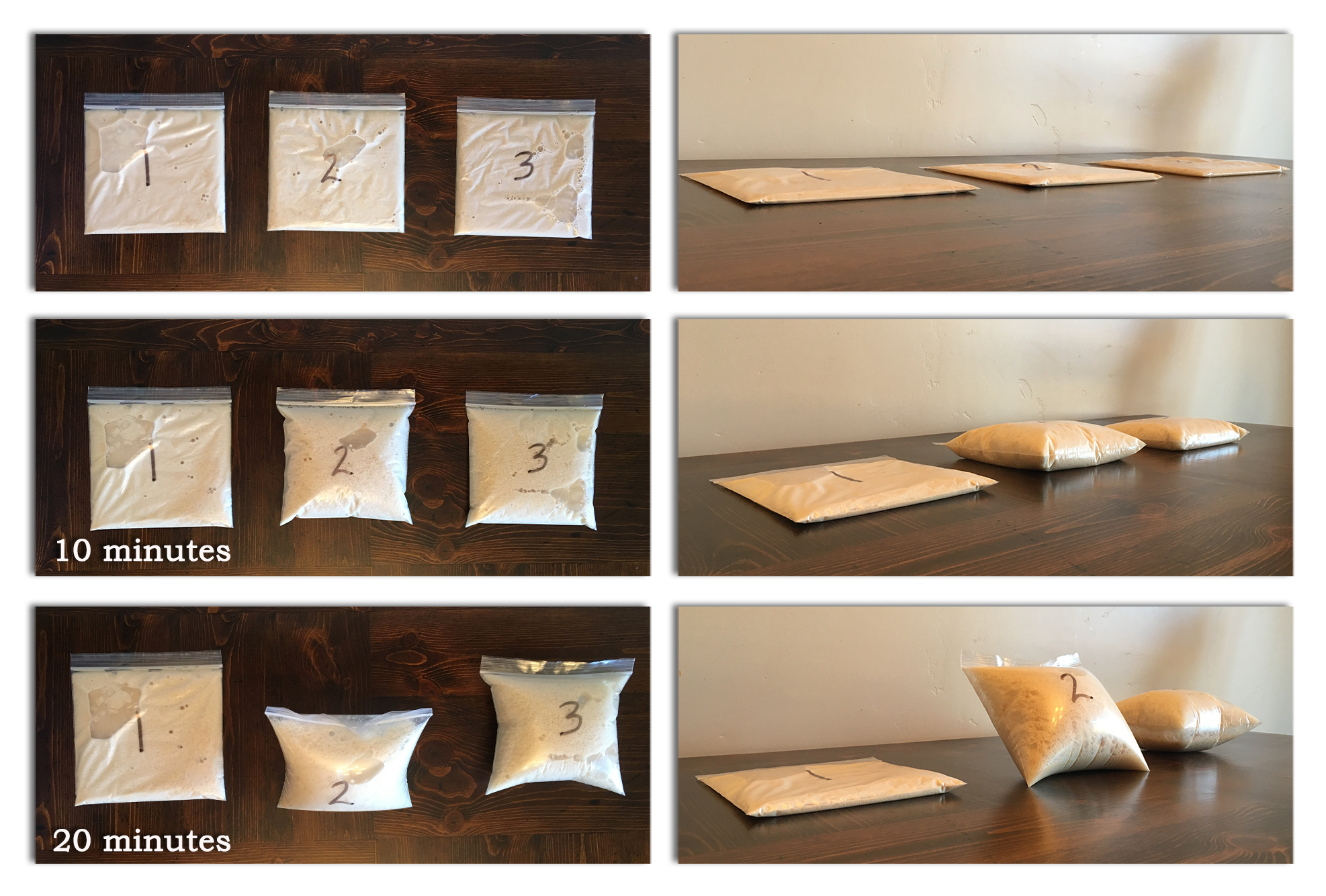
Activity 2: Bread Dough Challenge
- Ask students if they can name any food products that are made using yeast and alcoholic fermentation. Examples include bread, beer, and wine.
- Tell students that one of the challenges to making bread (at home or on the industrial scale) is the time that it takes to allow the dough to rise. Food scientists use engineering, biology, and chemistry to evaluate and improve food products from the farm to the kitchen.
- Tell students that they are on a team of food scientists at a bread company. They will be working together to discover the best recipe and preparation procedures to produce quick rising bread. To test as many variables as possible, the class will be divided into small groups.
- Divide your class into 8-12 groups and assign each group one Bread Dough Challenge Variable . You can use any of the variables provided, or have students think of their own. Preselect the optional variables based on your class size and/or lab supplies available.
- Tip: As students determine their variables and how they will manipulate them for the experiment, allow them to pursue the wrong direction to provide an authentic learning experience and the opportunity to explain the outcome using science. For example, knowing that yeast needs sugar to grow, a student may greatly increase the amount of sugar in the recipe. If the yeast is not increased, this sample will not rise faster. It may not rise as much or even at all depending on the ratio. Refer to information about the molar concentration of sucrose for an explanation.
- Provide lab supplies, answer student questions, and tell students where to take their dough once it is mixed. Have students fold their variable card in half to make a tent label to identify their dough.
- Using a dry erase marker, have each group place a starting line on their jar at the level of the dough.
- Allow at least 30 minutes for the bread dough to rise. Instruct students to place a second line at the level of the dough after 30 minutes.
- Place all dough jars for students to observe. After observation time is over, allow students time to complete the last page of their handout which will contain their final recommendation to the bread company.
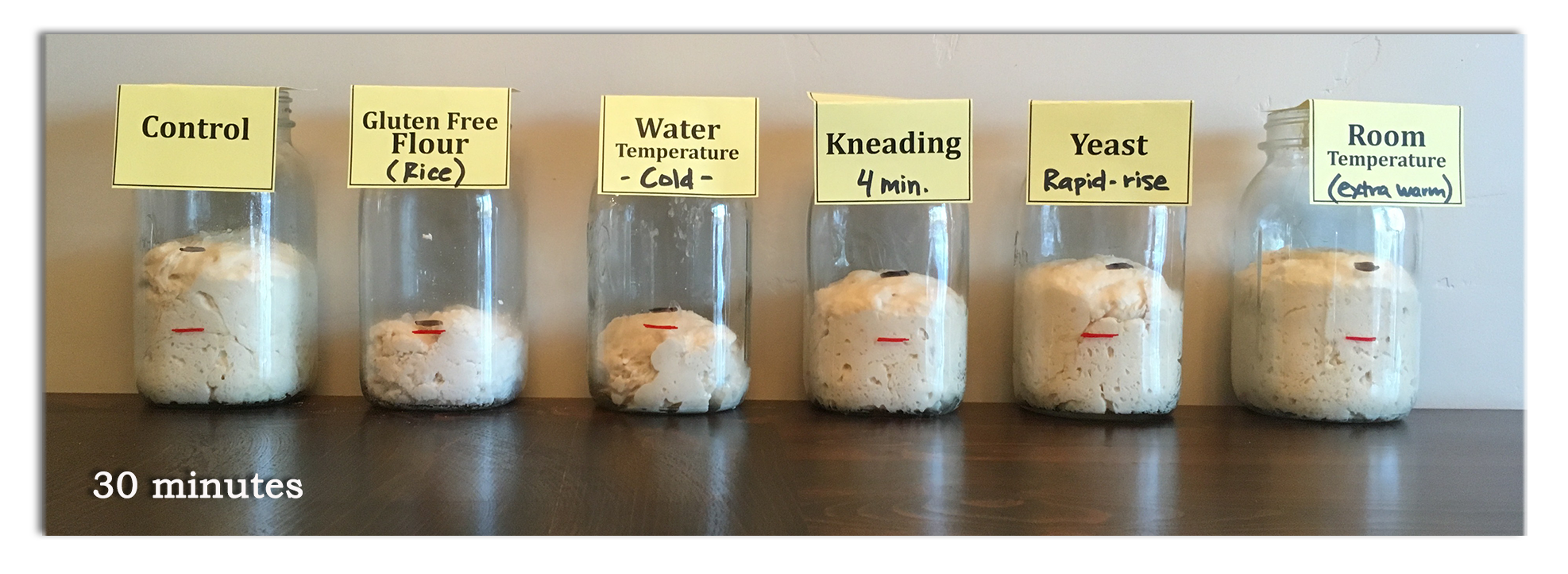
Have students complete the attached Cellular Respiration concept map . Print the blank diagram (page 1) or the diagram with hints (page 2). Students can use a textbook or internet search to complete the diagram. The word bank on page 3 can also be projected or printed for reference. The teacher key is found on page 4.
Discover other foods that are created using the process of fermentation. Examples include cheese, sauerkraut, pickles, kimchi, and root beer. Divide the class into small groups. Assign each group to research a specific fermented food and create a "how to" brochure outlining how the food is made.
Show students where wheat is grown in the United States. Use the wheat map from the Interactive Map Project . Find your state and determine how much wheat your state grows annually.
Have students create a graph of their data and the control from Activity 2. Students can create the graph by hand or by using graphing software such as Google Spreadsheets or Microsoft Excel. Have each group display their graph to the class.
After conducting these activities, review and summarize the following key concepts:
- Food Science is a career area in agriculture. Many agricultural companies employ food scientists to develop raw agricultural commodities into marketable food products.
- Science is used to produce and process our food. The process of alcoholic fermentation is used in making bread dough.
- Bread dough rises as yeast processes sugar and produces carbon dioxide, the gas that makes the dough rise.
- Gluten is the protein found in wheat flour.
- https://mobile-cuisine.com/did-you-know/bread-fun-facts/
- https://wiki.kidzsearch.com/wiki/Yeast
- http://www.ilove2bake.co.za/learn-more-about-yeast-6-8-interesting-facts/
- https://redstaryeast.com/science-yeast/what-is-yeast/
Acknowledgements
This lesson was originally written by Ann Butkowski for Minnesota Agriculture in the Classroom. It was updated and revised in 2019 by the National Center for Agricultural Literacy.
Phenomenon chart adapted from work by Susan German. German, S. (2017, December). Creating conceptual storylines. Science Scope , 41(4), 26-28. German, S. (2018, January). The steps of a conceptual storyline. Science Scope , 41(5), 32-34.
Recommended Companion Resources
- Amazing BREAD Processing- How It's Made Inside a Factory
- Dirt to Dinner
- Modern Marvels: World's Largest Combine
Ann Butkowski and Andrea Gardner
Organization
Minnesota Agriculture in the Classroom and National Center for Agricultural Literacy
Culture, Society, Economy & Geography
- Describe essential agricultural careers related to production, consumption, and regulation (T5.9-12.d)
Science, Technology, Engineering & Math
- Predict the types of careers and skills agricultural scientists will need in the future to support agricultural production and meet the basic needs of a growing population (T4.9-12.f)
Education Content Standards
Career & technical education (career).
AFNR (Grades 9-12) Food Products and Processing Systems Career Pathway
- FPP.02.01 Apply principles of nutrition and biology to develop food products that provide a safe, wholesome and nutritious food supply for local and global food systems.
- FPP.02.02 Apply principles of microbiology and chemistry to develop food products to provide a safe, wholesome and nutritious food supply for local and global food systems.
AFNR (Grades 9-12) Career Ready Practices
- CRP.10.1 Identify career opportunities within a career cluster that match personal interests, talents, goals and preferences.
Science (SCIENCE)
HS-LS2 Ecosystems: Interactions, Energy, and Dynamics
- HS-LS2-3 Construct and revise an explanation based on evidence for the cycling of matter and flow of energy in aerobic and anaerobic conditions.
- HS-LS2-5 Develop a model to illustrate the role of photosynthesis and cellular respiration in the cycling of carbon among the biosphere, atmosphere, hydrosphere, and geosphere.
Common Core Connections
Anchor standards: writing.
CCSS.ELA-LITERACY.CCRA.W.7 Conduct short as well as more sustained research projects based on focused questions, demonstrating understanding of the subject under investigation.
Practice Standards: Mathematics
CCSS.MATH.PRACTICE.MP1 Make sense of problems and persevere in solving them. Students start by explaining to themselves the meaning of a problem and looking for entry points to its solution. They analyze givens, constraints, relationships, and goals. They make conjectures about the form and meaning of the solution and plan a solution pathway rather than simply jumping into a solution attempt. They consider analogous problems, and try special cases and simpler forms of the original problem in order to gain insight into its solution. They monitor and evaluate their progress and change course if necessary. Students check their answers to problems using a different method, and they continually ask themselves, “Does this make sense?” They can understand the approaches of others to solving complex problems and identify correspondences between different approaches.
CCSS.MATH.PRACTICE.MP5 Use appropriate tools strategically. Students consider the available tools when solving a mathematical problem. These tools might include pencil and paper, concrete models, a ruler, a protractor, a calculator, a spreadsheet, a computer algebra system, a statistical package, or dynamic geometry software. Students at various grade levels are able to identify relevant external mathematical resources, such as digital content located on a website, and use them to pose or solve problems. They are able to use technological tools to explore and deepen their understandings of concepts.
How can we help?
Send us a message with your question or comment.
- Skip to primary navigation
- Skip to main content
- Skip to primary sidebar

- FREE Experiments
- Kitchen Science
- Climate Change
- Egg Experiments
- Fairy Tale Science
- Edible Science
- Human Health
- Inspirational Women
- Forces and Motion
- Science Fair Projects
- STEM Challenges
- Science Sparks Books
- Contact Science Sparks
- Science Resources for Home and School
What is Yeast?
January 21, 2012 By Emma Vanstone 4 Comments
Yeast is a living single celled organism commonly used in baking. Yeast is a type of leavener ( baking soda and baking powder can also be used as leavening agents ). Yeast converts sugar and starch ( from the sugar and flour in the bread mix ) into carbon dioxide and ethanol. The carbon dioxide gas makes the dough rise. Yeast works best in a warm, moist environment, which is why it’s best to leave the dough somewhere warm to rise. This conversion of sugar into carbon dioxide and ethanol is called anaerobic respiration.
We can see respiration occurring in yeast when we make bread or pizza dough.
Note – respiration in yeast is anaerobic respiration – this means it doesn’t use oxygen
Pizza Dough Respiration Investigation
Pizza dough ingredients.
500g Strong White Flour
7g Yeast (Fast)
1tbsp caster sugar
330ml Luke warm water
1tbsp olive oil
How to make pizza dough
- Mix the yeast, sugar and water in a jug and put to one side.
- Sieve the flour into a mixing bowl and add a pinch of salt.
- Gradually add the water until a nice elastic dough is formed.
- Knead the dough well, strong flour will take a lot of effort to get nice and elastic, so work it hard.
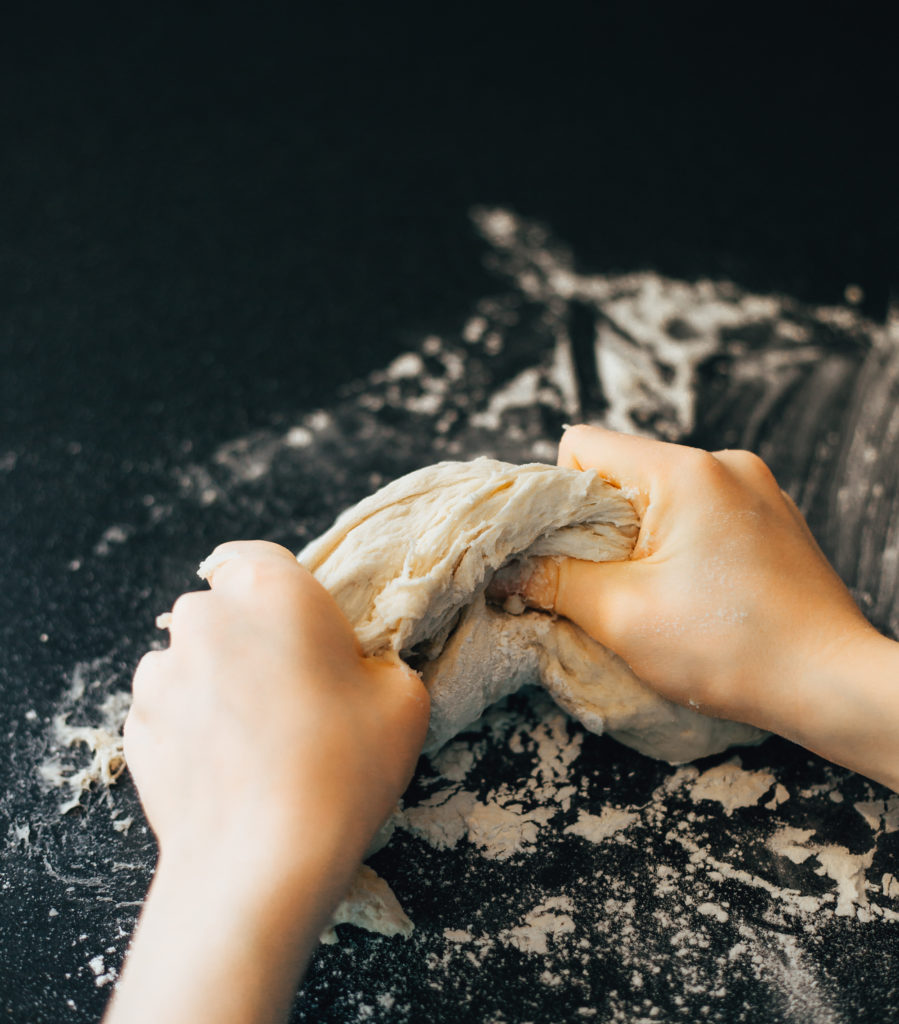
Leave it somewhere warm, we left ours in the airing cupboard for about an hour. Look how much it increased in size.
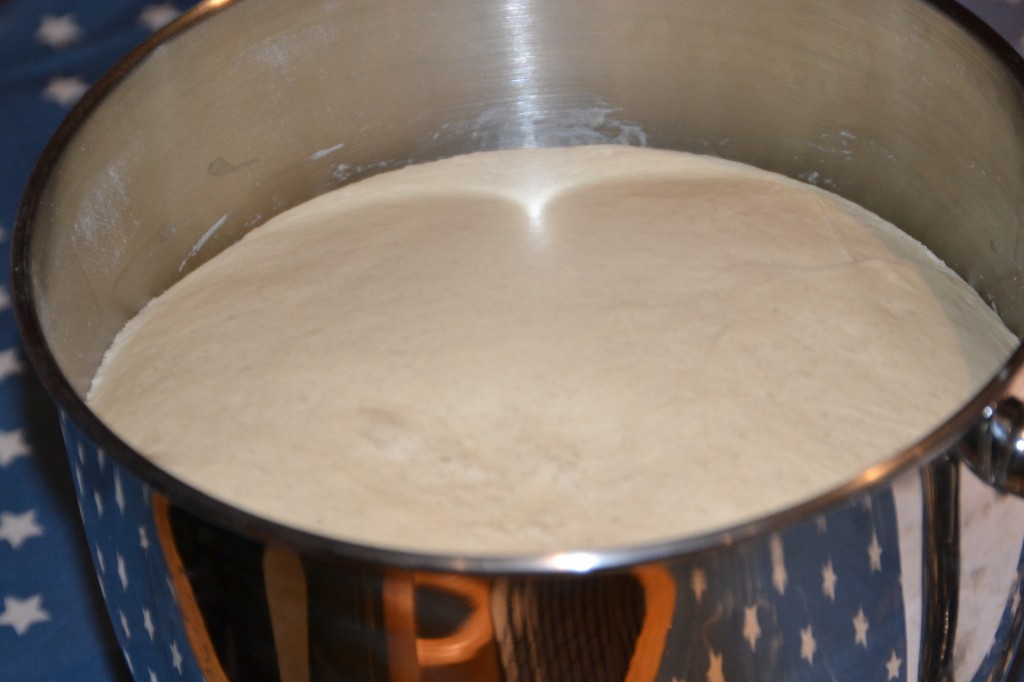
Once risen, knead the air out of the dough again and roll it out to make your pizza bases.
We turned our pizza into a plant cell model . The green peppers are chloroplasts!
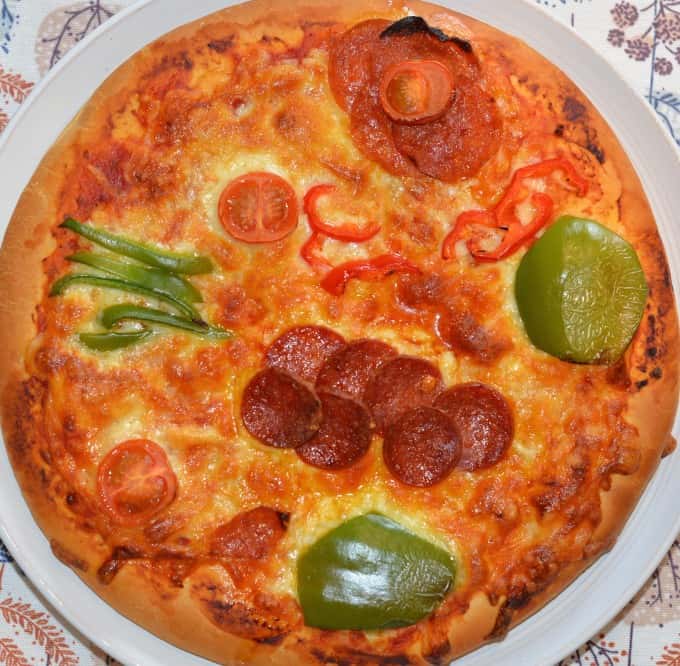
More Yeast Experiments
Did you know you can use the power of yeast to blow up a balloon ? First blow up the balloon and let the air out. Pour a packet of yeast, warm water and a tablespoon of sugar into a small bottle and quickly pop the balloon on top. Give the mixture a shake and you should find the balloon blows up thanks to the carbon dioxide gas produced by the yeast.
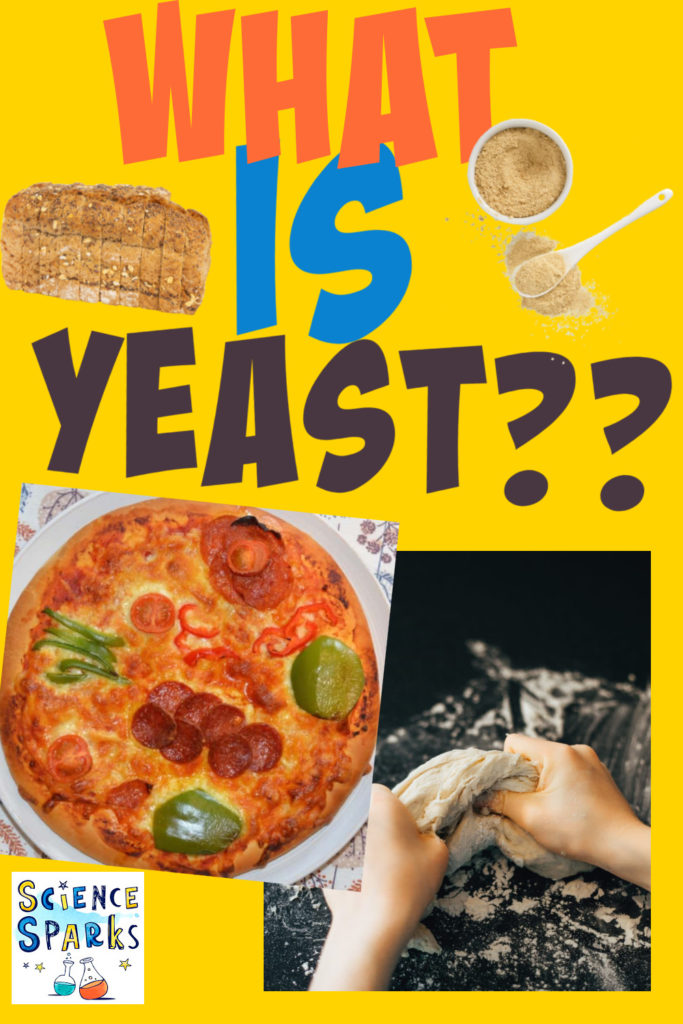
Last Updated on June 16, 2021 by Emma Vanstone
Safety Notice
Science Sparks ( Wild Sparks Enterprises Ltd ) are not liable for the actions of activity of any person who uses the information in this resource or in any of the suggested further resources. Science Sparks assume no liability with regard to injuries or damage to property that may occur as a result of using the information and carrying out the practical activities contained in this resource or in any of the suggested further resources.
These activities are designed to be carried out by children working with a parent, guardian or other appropriate adult. The adult involved is fully responsible for ensuring that the activities are carried out safely.
Reader Interactions
Leave a reply cancel reply.
Your email address will not be published. Required fields are marked *

IMAGES
VIDEO
COMMENTS
Blow up a balloon when yeast reacts with sugar in this classic yeast science experiment. Kids will love this simple kitchen science project!
Yeast is a fascinating sugar-loving fungi. In this experiment, Mary ellen shows you how to test its rising capacity based on what you mix it with.
The carbon dioxide makes the bread rise, while the ethanol evaporates when the bread is baked. In this experiment, students investigate the effect of different temperatures on yeast activity and the expansion of the bread dough.
Yeast actually eat sugar so that they can reproduce and make more yeast, and make bread dough rise. But can they use sugar substitutes to do this? In this science project you will get to investigate how well yeast grow with sugar substitutes as a food source.
Being classified as fungi (the same kingdom as mushrooms), yeast is more closely related to you than plants! In this experiment we will be watching yeast come to life as it breaks down sugar, also known as sucrose, through a process called fermentation. Let’s explore how this happens and why! Problem. What is sugar’s effect on yeast?
The pockets of gas are produced by yeasts when the dough is allowed to rise before baking. Fermentation is also used to make beer, wine, and champagne. In this microbiology science project, you will grow yeasts in different conditions to see which cause the yeasts to be most active during fermentation.
Your experiment was testing the effect of water temperature on the growth of yeast. Yeast are egg-shaped microscopic cells of fungi that are dormant whilst kept in dry and cool conditions. However, yeast will rapidly divide once exposed to water and sugar in ideal temperatures.
Using baker's yeast, students will observe alcoholic fermentation and its connection to cellular respiration as they are challenged to act as food scientists and develop the best recipe for quick-rising bread dough.
Yeast converts sugar and starch ( from the sugar and flour in the bread mix ) into carbon dioxide and ethanol. The carbon dioxide gas makes the dough rise. Yeast works best in a warm, moist environment, which is why it’s best to leave the dough somewhere warm to rise.
This short film conducts an experiment to find out the best temperature to activate yeast for breadmaking.